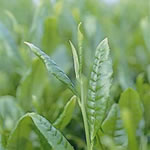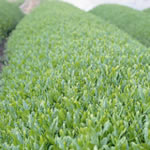Home > Teach me Tea Cha! > Cultivars > Yamanoibuki
Main content starts here.
Yamanoibuki
Yamanoibuki: Fragrant, early-growing cultivar, suitable for cultivation in combination with Yabukita


Cultivar characteristics
“Yamanoibuki” is an early-maturity cultivar whose harvest is four to five days earlier than “Yabukita”. The tree is slightly upright and extremely vigorous. Adult leaves have an elliptical shape with a slightly shorter tip, and the leaf color is green. The buds in the plucking season are good and of uniform shape, and the weight per 100 buds is slightly smaller than “Yabukita”. Yield is comparable to that of “Yabukita”, resistance to cold and red wilt is strong; “Yamanoibuki” is slightly more resistant to disease anthracnose compared to “Yabukita”. It is vulnerable to damping-off and white peach scales, similarly as weak as “Yabukita”
Quality characteristics
Although it is an early-maturity cultivar, “Yamanoibuki”, has a very good infusion color, aroma and flavor. In particular, it has a fresh uplifting aroma and ample umami with little astringency. In terms of chemical components, it has a high content of amino acids and theanines, which are called umami components, and a low content of catechin, astringent component.
Notes on cultivation
Due to its vigor and the slightly upright shape of the tree, it is necessary to pay attention to tailoring during the young stage and work to secure a stock. It is an early-maturity cultivar and thus, it is necessary to take thorough measures against frost and frost damage. In addition, it is weak for damping off and white peach scales, as vulnerable as “Yabukita”, and thus, prevention measures are necessary.
Notes on processing
“Yamanoibuki” has a stronger umami and less astringency for its infusion color. It is necessary to study the manufacturing method in detail in the future, but the steaming degree of about 30 seconds brings excellent shape and color, and that of about 45 seconds brings the excellent internal quality such as aroma, infusion color and flavor.
Dissemination and land suitability for cultivation
Although “Yamanoibuki” is an early-maturity cultivar, it has a wider range of adaptation areas than “Ooiwase” because it is resistant to cold, anthrax and has a strong vigor. However, being an early-maturity cultivar, it is suitable for cultivation in a moderate temperature zone with less frost damage.
